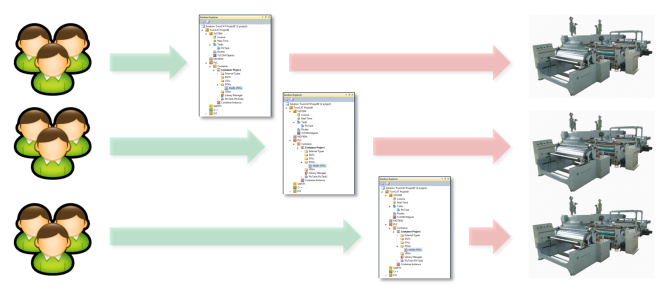Product description
The TwinCAT Automation Interface enables the automatic creation and manipulation of TwinCAT XAE configurations via programming/scripting code. The automation of a TwinCAT configuration is available through so-called automation interfaces which can be accessed from all COM-capable programming languages (e.g. C++ or .NET) and also from dynamic script languages - e.g. Windows PowerShell, IronPython or even legacy VBscript. These automation interfaces are bound to the Visual Studio Automation Model and extend Visual Studio with TwinCAT3 features.

TwinCAT Automation Interface enables an efficient engineering process by giving customers the possibility to automate the configuration of a full TwinCAT solution.
Traditionally, a machine configuration had to be manually adapted to each new project or had even to be created from scratch, which could not only involve a tremendous amount of engineering time and therefore costs but is also error-prone because of human mistakes.

With TwinCAT Automation Interface, the process of adapting TwinCAT configurations to a new environment or even create new TwinCAT configurations from scratch can be automated according to the customers needs.

Readers should continue with the following topics:
Basics
|
Topic |
Description |
|---|---|
|
Describes how to create or open a TwinCAT configuration | |
|
Describes how to navigate through a TwinCAT configuration | |
|
Describes how to access custom parameters of an item. This is important to access configuration parameters of a TwinCAT tree item. | |
|
Describes how to implement an own COM message filter to circumvent rejected COM calls |
Best practice
|
Topic |
Description |
|---|---|
|
Describes how to handle PLC projects | |
|
Describes how to handle PLC objects/code | |
|
Describes how to handle PLC libraries, repositories and placeholder | |
|
Describes how to create TwinCAT Motion projects (NC-Task, Axes, ...) | |
|
Describes how to create EtherCAT devices and connect them to an EtherCAT topology | |
|
Describes how to handle TwinCAT Measurement projects. | |
|
Describes how to handle TcCOM modules. | |
|
Using templates |
Describes the process of template generation and template usage. |
|
Describes how to create network variables (publisher/subscriber variables) | |
|
Describes how to create Tasks and link them with other objects (PLC-Projects, ...) | |
|
Some IO devices need physical address information before the configuration can be activated. This article explains how to retrieve and set this information. | |
|
The Error List can be very helpful for debugging and diagnostic purposes | |
|
Describes how to get access to Visual Studio windows. | |
|
Describes how different Versions of Visual Studio can be used for Automation Interface | |
|
Demonstrates how you can attach to existing (already running) Visual Studio instances to use Automation Interface | |
|
Describes how to set the TwinCAT target platform for compilation. |
Additionally, this documentation also includes a full API reference of all interfaces. The How to and Sample sections offer a free composition of script code fragments, configuration steps and demo projects. They also contain an unsorted and growing list of "real-world" samples.